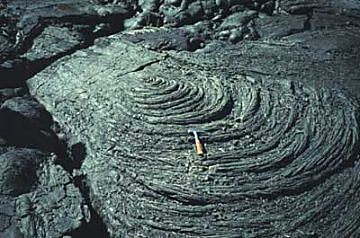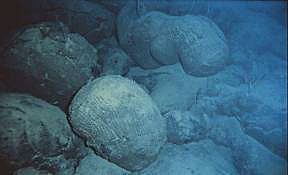
A Pedreira do Campo corresponde a uma antiga frente de exploração que expõe uma sequência submarina completa composta por rochas sedimentares marinhas com rico conteúdo fossilífero na base, sobrepostas por hialoclastitos basálticos: esta sequência tem cerca de 5 milhões de anos.
Focando esta earthcache, ao nível de assunto, no tipo de lavas, a
s lavas, conforme a sua composição e o tipo de arrefecimento (lento ou rápido) a que foram submetidas, podem apresentar à superfície aspectos muito variados. Surgem assim as:
| 1) lavas encordoadas ou "pahoehoe", que se caracterizam pelo aspecto rugoso que apresentam; durante a consolidação, surge, em primeiro lugar, uma fina crosta superficial debaixo da qual a lava continua a fluir, enrugando-a e dando-lhe a forma final de um encordoamento; são típicas de erupções efusivas |
 |
| 2) lavas escoriáceas ou "aa", que se caracterizam por apresentarem uma superfície irregular, com saliências ponteagudas; têm origem em lavas viscosas, com elevada percentagem de gases, que solidificam rapidamente; são típicas de erupções explosivas; |
 |
| 3) lavas em almofada ou "pillow-lavas", que se caracterizam pelo seu aspecto tubular ou em rolos; são típicas dos derrames submarinos, sendo o seu aspecto resultante do rápido arrefecimento da lava em contacto com a água. |
 |
 Sobre a Earthcache
Sobre a Earthcache
Para a poder logar terá de cumprir as sequintes tarefas:
a) Como "aquecimento" que o levará a observar todo o fenomeno, gostaria de saber qual o comprimento da Pedreira do Campo, alvo do nosso estudo?
b) No GZ encontra exemplos evidentes e identificadores claros de um tipo de lava, qual ?
c) Qual o tipo de rocha presente ?
d) Qual o diâmetro do fenomeno presente no GZ ?
e) O que observa neste fenomeno ao nivel de textura e cor ? E a sua forma ?
f) Explique pelas suas palavras a formação deste tipo de lava / fenomeno.
Apesar de ser opcional gostamos sempre de ver umas fotos por isso apelamos a que inclua pelo menos uma no seu log. (nada de spoilers, por favor).
Envie as respostas através do meu perfil de geocaching e divirta-se!
Se é um amante de trilhos, pode encontrar AQUI o registo de um percurso (em formato gpx zipado em rar) o qual poderá descarregar e usar, se assim o entender. Ele irá conduzi-lo num trilho bonito que passa por esta Earthcache e acaba em duas bonitas praias.
Divirta-se com o Earthcaching

The Campo Quarry (Pedreira do Campo) was a former front operation that exposes a complete underwater sequence composed of marine sedimentary rocks with rich fossil content base, overlaid by hialoclastitos basaltic lavas and subsea pad: this sequence has about 5 million years.
Focusing our subject on the lava types:
1) "pahoehoe" lava means "smooth, unbroken lava", is basaltic lava that has a smooth, billowy, undulating, or ropy surface. These surface features are due to the movement of very fluid lava under a congealing surface crust.
A pahoehoe flow typically advances as a series of small lobes and toes that continually break out from a cooled crust. It also forms lava tubes where the minimal heat loss maintains low viscosity. The surface texture of pahoehoe flows varies widely, displaying all kinds of bizarre shapes often referred to as lava sculpture.
2) "aa" lava is one of three basic types of flow lava. "aa" is basaltic lava characterized by a rough or rubbly surface composed of broken lava blocks called clinker.
The loose, broken, and sharp, spiny surface of an "aa" flow makes hiking difficult and slow. The clinkery surface actually covers a massive dense core, which is the most active part of the flow. As pasty lava in the core travels downslope, the clinkers are carried along at the surface. At the leading edge of an "aa" flow, however, these cooled fragments tumble down the steep front and are buried by the advancing flow. This produces a layer of lava fragments both at the bottom and top of an "aa" flow.
3) Pillow lava is the lava structure typically formed when lava emerges from an underwater volcanic vent or subglacial volcano or a lava flow enters the ocean. However, pillow lava can also form when lava is erupted beneath thick glacial ice. The viscous lava gains a solid crust on contact with the water, and this crust cracks and oozes additional large blobs or "pillows" as more lava emerges from the advancing flow. Since water covers the majority of Earth's surface and most volcanoes are situated near or under bodies of water, pillow lava is very common.
 About the Earthcache
About the Earthcache
To claim this earthcache you need to fulfill the following tasks:
a) To warm you up, let's start to ask how wide is this quarry phenomenon (Pedreira do Campo)?
b) At the gz you will find clear samples of one type of lava. Which one ?
c) What is the rock type ?
d) What is the diameter of one of the lava phenomenon ? what about he shape?
e) What can you observe on this type of lava phenomenon concerning colour and texture ?
f) By your own words explain the formation of this kind of phenomenon / lava type.
Also, and despite being optional, please take a photo with your GPS (no spoilers please).
Send the responses via my geocaching profile and enjoy the Earthcache.
If you are a hiker, you can find HERE a gps track (gpx format inside a rar zipped file) to download that you might like to use and that along the way leads you to this Earthcache. Also you will have the bonus of finish in two wonderfull bathing places.
Happy Earthcaching
FTF -
STF -
TTF -